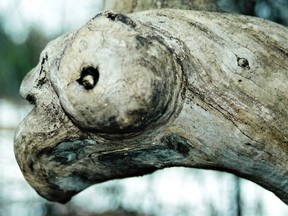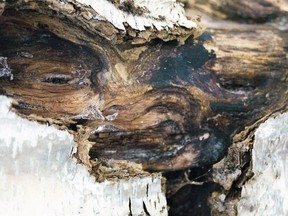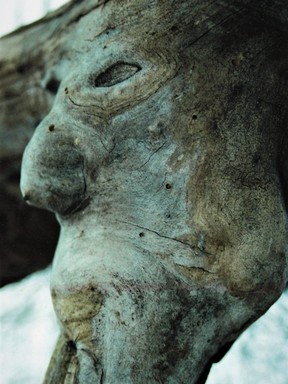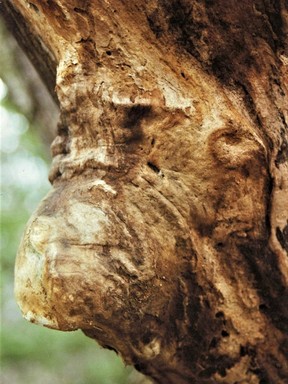Large Funny Comical Eyes in Trees
Seeing faces in trees correlates to creativity, and cognitive scientists are taking interest
Seeing faces in things is not a bug in human cognition. It is a feature, called pareidolia

There are moments in the history of science that become fables about sudden insight, simple storybook scenes, like Archimedes in the bath, Newton under the apple tree or Einstein in the patent office.
Cognitive psychology has the makings of another one in the hobby photography of Ronald Senack, 63, who walks the woods of eastern Ontario, collecting evidence for the wild truth that human minds project into the natural world.
Senack sees faces in things, trees mainly, ghostly apparitions of eyes and mouths in knots of damaged bark or the stains of time on decomposing wood.
He is not a scientist, but he is doing real field work collecting these unusual stimuli, which are being used in academic laboratories around the world in studies of pareidolia, the false recognition of patterns or meanings in nature. At first, this was because of Senack's determined belief that these illusory faces were of value to science, and should be brought to the widest possible attention. Eventually, it was because scientists realized he was right.

Jessica Taubert, for example, a scientist at the U.S. National Institute of Mental Health, is interested in the importance of exaggerated expressions, why illusory faces tend to be expressing intense emotion. Catherine Mondloch of Brock University in Ontario, studies normal face perception, recognition of individual faces, and how it changes across the human lifespan. Other researchers are using Senack's images to test and explain the propensity to facial pareidolia in people with dementia, motor neuron disease and schizophrenia.
More fundamentally, as University of Toronto facial processing expert Kang Lee puts it, Senack's images show that the world we see is not entirely determined by what is out there. On the contrary, much of what we see, or think we see, is constructed through our brain.
Seeing a face in tree-bark is an "extreme illustration of how our brain actively interprets the world," Lee says.

It is of diverse scientific interest. A paper published just this week, for example, showed the propensity to pareidolia correlates with creativity.
Mondloch knows the power of these serendipitous arrangements of eyes and nose. She has done experiments with newborns showing that the very simplest stylized face is enough to grab their attention. For adults, this instinct has become irresistible.
"You can't not see it," Mondloch says. From the minute we are born, humans have "a huge sensitivity to anything that might be face-like."
Seeing faces in things is not a bug in human cognition. It is a feature.
Senack, who lives in Brockville, Ont., started doing this after he was injured in an accident and decided to become a nature photographer. So, he started walking deep into woods and farmland familiar to him from childhood.

"I really had no idea," he says. "I was just looking for something that was totally different."
Some faces he noticed right away, others only after ripping away some old bark. Some he shot up close and lying down. A few he noticed only after developing pictures.
The first general principle he noted was that the faces all seem to come from injury or age. The wizardly one in a knot of cedar is in a stump that is probably 100 years old. The baboon is on a dead tree near where he has a cottage in the Rideau Lakes.
Finding faces in the woods is kind of like fishing. You have to know where to go, and you cannot go whenever you want. You have to go when the leaves are off the trees, in fall or winter.
"Once the leaves are on the trees, everything's hid," he says.
He remembers as a kid seeing a face in a patterned curtain viewed from his bed, but not wanting to tell his family for fear it would sound weird, even psychotic. He would try to see it every now and then, not always succeeding.
"You have to be just on that right angle. I guess that's what makes it able for me to see these images in the trees," he said. "I know that you gotta look on angles."

Faces are special to the brain. And it is the brain that makes the faces in the tree, not the tree itself. Sorting that out is a surprisingly baffling problem, and it recalls the earliest philosophical wondering about the eye, whether it cast some illuminating fire onto the world or simply took it in.
A key insight of modern psychology is how the brain creates faces out of the world, illuminating them for the mind.
The idea is similar to what the Enlightenment-era philosopher Immanuel Kant called the Copernican Turn in philosophy. Thinking the world conforms to our minds and not vice versa is as revolutionary as thinking the sun is the centre of the solar system, not the Earth, as Copernicus realized.
And yet that is how it is.
Many parts of the brain are involved in vision, but there is one area, the fusiform face area, that is known to be specialized to recognizing faces. A stroke here can cause face-blindness, known as prosopagnosia. Stimulating it causes faces to appear.
In 2017, scientists in Japan, Austria and the U.S. reported that simply by stimulating this area with an electrode in a young man with epilepsy (who had many electrodes in his brain to control his seizures, like a cardiac pacemaker), they could make him see faces in things, such as a soccer ball and a box.

They could induce facial pareidolia. This was not a hallucination. The face did not obscure what was behind it in the man's visual field. It simply emerged from what he was seeing.
As the anonymous subject described it, "just for the very first second I saw an eye, an eye, and a mouth … How do I explain this? … Hm. Am I just imagining things? Can you do it again? OK, just as I thought, I see a face."
Lee at UofT says people can cultivate this faculty, get better at it by practice, like Senack. He used the analogy of a walk home at night, when higher order processes like vigilance can make a person prone to seeing things in the shadows that are not really there. If you try to look, you tend to find.
Pareidolia like Senack's tree people show how much we are seeing the world with the help of higher order cognitive processes, Lee says. They illuminate faces that are not even there, until by looking we put them there.
• Email: jbrean@nationalpost.com | Twitter: josephbrean
longoriasking1984.blogspot.com
Source: https://nationalpost.com/news/seeing-faces-in-trees-correlates-to-creativity-and-cognitive-scientists-are-taking-interest

0 Response to "Large Funny Comical Eyes in Trees"
Post a Comment